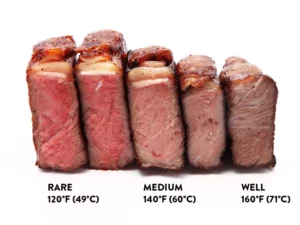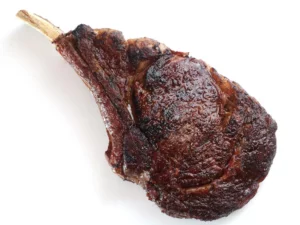The reverse sear steak technique could revolutionize the way you prepare beef. This method includes two steps; baking in the oven followed by a hot pan sear. It has garnered popularity among readers receiving enthusiastic reviews!
Recipe Science
The even and steady warmth, inside the oven allows for regulation of the temperature avoiding the risk of overcooking. Baking below 300 degrees triggers enzymes that help to tenderize the meat. Finishing with a sear in a pan creates a golden crust thanks, to the Maillard Reaction.

Why It Works
During my time, at cooking school I learned to sear filet mignon or ribeye in a pan to seal in the flavors. Through experiments I’ve discovered that browning creates an outer layer though the level of juiciness can differ. A thick steak needs cooking time often resulting in dry edges with only a hint of pink, in the middle.
Americas Test Kitchen showed me the sear technique. It has been my favorite method ever since. With reverse sear you start by cooking the meat in the oven before giving it a sear, on the stovetop.
- You don’t have to let the steak come to room temperature for it to cook evenly; the oven can handle that quickly!
- The heat, from the oven helps to remove any moisture on the surface making it perfect, for searing in a pan.
- The pink color inside should be more uniform, with edges, from cooking.
- A thick slice of beef can be cooked delicately to the level of doneness.
- Searing the food quickly on the stovetop creates a crust. Enhances its flavor beautifully.

Ingredients You’ll Need
- Steak: For cuts of steak it’s ideal to use the sear method especially for those that are at least 1 ½, to 2 inches thick. Thinner cuts under 1 inch tend to cook. Opt for a high quality steak with some marbling, such, as USDA prime or choice. My favorite picks include ribeye, top sirloin, New York strip, porterhouse, T bone and filet mignon.
- Oil: For searing the steaks opt for a high smoke point oil such, as oil, light olive oil, soybean oil or vegetable oil. For flavor consider using butter.
- Butter: I like to brush the steak with butter when its almost ready. The butter. Gives the meat a toasted smell and taste.
- Seasonings: Enhancing the flavor, salt and black pepper seasonings work wonders. This method truly elevates the taste and texture of the meat.
- Herbs: I added some thyme sprigs to the steak while searing to give it a flavor boost. You could also try using sage or oregano for a taste.
- Garlic: Adding a couple of cloves will enhance the flavors of the dish beautifully.
- Shallots: I prefer to add a shallot while searing the steak to give it a hint of onion flavor.
Temperature and Timing

| For 1 1/2–Inch Steaks in a 250°F (120°C) Oven | |||
|---|---|---|---|
| Doneness | Target Temperature in the Oven | Final Target Temperature | Approximate Time in Oven |
| Rare | 105°F (40°C) | 120°F (49°C) | 20 to 25 minutes |
| Medium-Rare | 115°F (46°C) | 130°F (54°C) | 25 to 30 minutes |
| Medium | 125°F (52°C) | 140°F (60°C) | 30 to 35 minutes |
| Medium-Well | 135°F (57°C) | 150°F (66°C) | 35 to 40 minute |
How to Reverse Sear Steak
Step 1: Heat the Oven
Place the rack in the middle to ensure the heat is evenly distributed. Preheat the oven to 275°F (135ºC). Cover a baking sheet, with foil or parchment paper and place a wire rack on top of it.
Step 2: Prepare the Steaks
Pat the steaks dry, with paper towels to get rid of any moisture. Place them on the wire rack and season both sides, with salt and pepper.
Pro Tip: Refrigerate the meat uncovered for 2 to 24 hours before cooking for a drier surface and more well-seasoned steak.
Step 3: Cook the Steak in the Oven
Put the steaks in the oven that you’ve already preheated. Cook them for 15 to 25 minutes depending on how thick they’re how well done you want them. They should be, around 30 degrees cooler, than the temperature you plan to serve them at.
Tips for Perfect Execution: Use an instant-read meat thermometer to check the internal temperature of the thickest part of the steak.
Step 4: Pan Sear the Steak
Heat up a cast iron skillet or stainless steel pan on heat. When it’s hot pour, in the oil. Make sure to sear each side for approximately 1 to 2 minutes. Cook the edges to release the fat taking around 30 to 60 seconds, per side.
Step 5: Baste with Butter
Lower the heat, to a setting and then introduce the butter. Use a spoon to drizzle the butter, over the steaks allowing them to cook for 2 minutes to improve their color and taste.
Feel free to get creative; Include ingredients such, as chopped garlic, shallots or a touch of rosemary or thyme. Add them towards the end while brushing with the butter.
Step 6: Rest, then Serve
After cooking the steak place it on a plate or back, on the wire rack over a baking sheet. Let it rest for 5 to 10 minutes so that the residual heat can continue cooking the meat. While I prepare the side dishes I notice that the steak is just right, in terms of serving temperature.
Cut the steak into slices. Serve it either on its own or, with a side of Maître D’ Butter.
Make-Ahead and Storage
For results enjoy the reverse seared steak after cooking. If reheating is necessary lightly sear it in a pan, with smoked oil until warm. Store the steak covered in the refrigerator for, up to 3 days. Note that this dish may not freeze well.

Chef Notes + Tips
- I like to use olive oil, ghee, clarified butter or beef tallow when I cook. Feel free to use any fat or oil of your choice for cooking.
- If you think you’ve cooked it for long try standing it up while letting it rest to allow the heat to escape faster.
- If the steaks are lighter you might have to cook them for a minute, on each side.
- Feel free to use your favorite steak seasoning.
- Leaving the steak for, over 24 hours can result in it starting to dry out.
- When it comes to steak the top choices, for pans are cast iron or carbon steel.. Feel free to use whatever you’ve got on hand.
- When you cook a steak, at temperatures between 285°F and 350°F something called the Maillard reaction occurs. It’s like a chemistry dance between the sugars and amino acids in the meat that gives it that browned crust and extra crunch. It’s different, from caramelizing.
- I like my steak cooked to a doneness so I take it out of the oven when it reaches an internal temperature of 100 degrees to give me flexibility when searing it in a pan and avoid overcooking.
- You will need at least a 12” pan to sear multiple steaks at a time.
Disadvantages of Reverse-Searing Steak
I have to confess reverse searing isn’t perfectly pink middles. There are three downsides, to this technique. Firstly it takes time. It’s quicker to season a steak and cook it in a pan flipping it occasionally until its done. Secondly reverse seared steaks don’t create fond – those browned bits that stick to the pan and form the base for sauces. So if you want a sauce with your reverse seared steak you’ll need to make it.
However this lack of fond in the pan isn’t really an issue because all those flavorful bits are already locked into your meat. You might discover that a reverse seared steak is delicious without any sauce all. Lastly this method isn’t ideal for steaks than an inch and a half as they tend to cook quickly. If you prefer steaks consider serving one steak, for every two people instead of opting for a thick two inch cut.

Is Sous-Vide Steak Better Than Reverse-Seared Steak?
The reverse sear was initially designed to imitate the effects of vide cooking. It has a distinct advantage when it comes to searing. Unlike vide steaks that can be wet and challenging to sear a steak cooked using the reverse sear method develops a superior crust resulting in a richer flavor profile. However if you prioritize consistency in your cooking and want to avoid overcooking sous vide remains the option. For information, on cooking vide steaks feel free to explore my comprehensive guide.

I spent a good bit of my 20’s touring the country playing music. As a teenager, and throughout my 20’s, in between music, I always worked in restaurants, in various capacities. Somewhere in my late 20’s I realized that I was not on the cover of Rolling Stone, as planned, and so, I started thinking about my future and trying to figure out other ways to have an impact, be creative and still live a bit of that rock ‘n roll lifestyle. The restaurant industry provided me with a good bit of those things. And so, I started honing my chops in the kitchen, putting my nose in food lover’s companion, and really started to go somewhere with it.